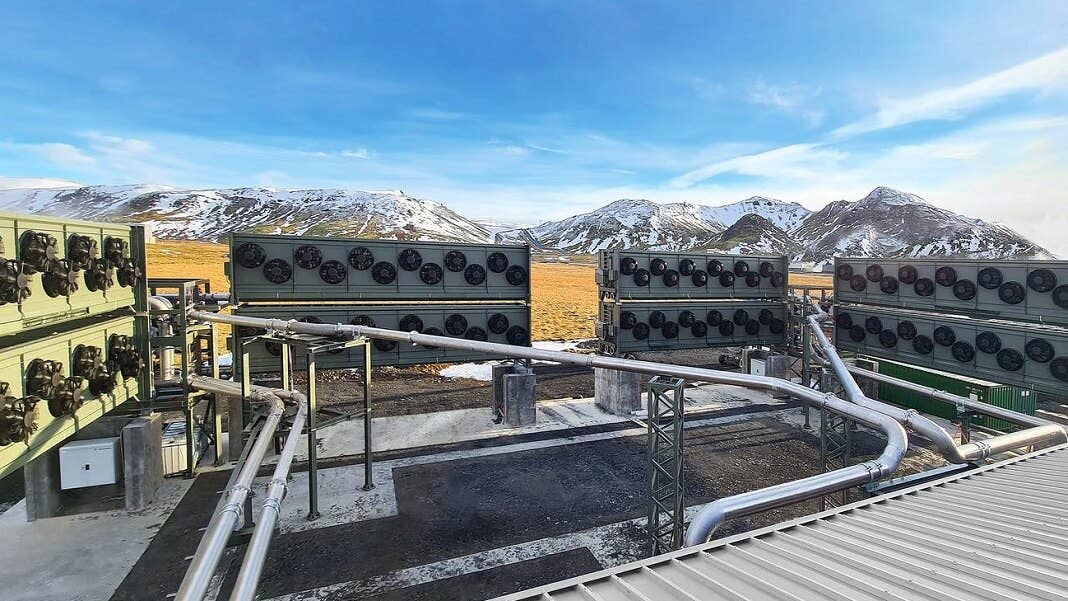Is it actually practical to convert captured carbon to fuel?
Last year, the world emitted over 37 billion metric tons of carbon dioxide, setting a new record high. Is carbon capture the answer?

Climeworks direct air capture system. (CREDIT: Climeworks)
The struggle to cut emissions is real.
Last year, the world emitted over 37 billion metric tons of carbon dioxide, setting a new record high. Consequently, sucking CO2 out of the atmosphere has become a popular idea. Governments worldwide are betting on this technology, called direct air capture, to help achieve climate goals and avoid the worst consequences of climate change.
Despite more than a dozen direct air capture facilities already operating globally, the technology still faces major hurdles—including high energy use.
In a study published in the journal ACS Energy Letters, researchers at the University of Colorado Boulder and collaborators revealed that a popular approach to reduce energy costs would, in reality, fail. The team, including scientists at the National Renewable Energy Laboratory in Golden, Colorado, and Delft University of Technology in the Netherlands, proposed an alternative, more sustainable design for capturing CO2 and converting it to fuels.
“Ideally, we want to take CO2 out of the air and keep it out of the air,” said Hussain Almajed, a Ph.D. student in Chemical and Biological Engineering. “However, some of this CO2 can be recycled into useful carbon-containing products. Some ideas look very simple and elegant on paper, but researchers rarely check whether they are practical and economical in industrial settings.”
One common direct air capture approach is using air contactors, essentially huge fans that pull air into a chamber filled with a basic liquid. CO2 is acidic, so it naturally binds to and reacts with the solution to form harmless carbonate (the main ingredient in concrete) or bicarbonate (the ingredient in baking soda).
Stratos, one of the world’s largest direct air capture facilities under construction in Texas, uses this approach.
Once CO2 is trapped in the carbonate or bicarbonate solutions, engineers must separate it out from the liquid so the liquid can return to the chamber to capture more CO2.
Meanwhile, the captured carbon can be converted into things like plastics, carbonated drinks, and even— with further processing—fuel to power homes and potentially airplanes.
But there is a catch. To release the trapped CO2, companies need to heat the carbonate and bicarbonate solution to at least 900˚C (1,652˚F), a temperature solar and wind energy cannot achieve. This step is usually powered by burning fossil-based fuels like natural gas or pure methane.
“If we have to release CO2 in order to capture CO2, it defeats the whole purpose of carbon capture,” said Wilson Smith, a professor in Chemical and Biological Engineering and a fellow of the Renewable and Sustainable Energy Institute at CU Boulder.
Researchers are actively looking for answers. One idea, known as reactive capture, is to apply electricity to the carbonate and bicarbonate solutions, zapping the CO2 and basic liquid apart in the chamber. In theory, the recycled liquid can then capture more CO2, forming a closed-loop system.
“Reactive capture is now the buzzword in the field, and researchers proposed that it could help save energy and costs associated with carbon capture. But no one really assessed whether that’s realistic under industrial conditions,” Almajed said.
To do that, the team calculated the mass and energy outputs of the reactive capture units, based on given inputs, to understand how well the overall system would perform. They found that in an industrial setting, electricity would not be able to regenerate the basic liquid to re-capture more CO2 from the air.
In fact, after five cycles of carbon capture and regeneration, the basic liquid could barely pull any CO2 out of the air.
The team also suggested a tweak to the reactive capture process by adding a step called electrodialysis. The process splits additional water into acidic and basic ions, helping to maintain the basic liquid’s ability to absorb more CO2. Electrodialysis can run on renewable electricity, making it a potentially sustainable way to turn captured CO2 into useful products.
More importantly, electrodialysis can release CO2 gas, which engineers can use to strengthen concrete.
“To me, turning CO2 into rocks has to be one of the leading solutions to keep it out of the air over long periods of time,” Smith said. Concrete production is energy-intensive and responsible for 8% of global carbon emissions.
“This is solving multiple problems with one technology,” he said.
According to the Intergovernmental Panel on Climate Change (IPCC), a team of scientists convened by the United Nations, carbon dioxide removal “is required to achieve global and national targets of net zero CO2 and greenhouse gas emissions.”
Worldwide, more than 20 direct air capture plants are in operation, with 130 more currently under construction.
But Smith stresses that while carbon capture may have its place, cutting emissions is still the most critical step needed to avoid the worst outcomes of climate change.
“Imagine Earth as a bathtub, with the running water from the faucet being CO2. The bathtub is getting full and becoming unlivable. Now, we have two options. We can use a little cup to scoop out the water, cup by cup, or we can turn the faucet off,” Smith said.
“Cutting emissions has to be the priority.”
Most widely used global direct air capture technologies
Direct Air Capture (DAC) systems are a growing technology aimed at removing carbon dioxide (CO₂) from the atmosphere. Here are some of the most widely used and prominent DAC systems globally:
1. Climeworks
Climeworks is one of the leading companies in the DAC sector. Based in Switzerland, Climeworks uses a technology that captures CO₂ directly from the air using a filter and then stores or reuses the CO₂. They have multiple operational plants, including the Orca plant in Iceland, which is the world's largest DAC plant.
2. Carbon Engineering
Carbon Engineering, a Canadian company, has developed a DAC technology that captures CO₂ from the air through a chemical process involving a potassium hydroxide solution. The captured CO₂ can then be used for synthetic fuels or stored underground. Their pilot plant is located in British Columbia.
3. Global Thermostat
Global Thermostat, an American company, employs a DAC technology that uses amine-based adsorbents to capture CO₂ from the air. Their modular system allows for scalability, and they have partnerships with companies to use captured CO₂ in various industries.
4. CarbFix
Although not exclusively a DAC company, CarbFix in Iceland collaborates with Climeworks and others to store captured CO₂ underground by mineralizing it into basalt rock formations. This process ensures permanent removal of CO₂ from the atmosphere.
5. Sustaera
Sustaera is a relatively new player in the DAC field, focusing on low-cost, scalable DAC technology. They use a proprietary process to capture and release CO₂ efficiently and aim to deploy their technology on a large scale.
6. Soletair Power
Soletair Power, a Finnish company, integrates DAC technology with renewable energy systems. They capture CO₂ and convert it into synthetic fuels using excess renewable energy, thus closing the carbon loop.
7. Heirloom
Heirloom, a U.S.-based startup, uses a novel approach by leveraging naturally occurring minerals to capture CO₂ from the air. Their technology accelerates the natural carbon mineralization process to capture and store CO₂ efficiently.
Common Features and Differences:
- Technology: While the basic principle of capturing CO₂ from the air is common, the methods vary significantly. Climeworks uses filters, Carbon Engineering uses a liquid solvent, Global Thermostat uses solid adsorbents, and Heirloom uses minerals.
- End Use: Captured CO₂ can be stored underground (Carbon Engineering, Climeworks, CarbFix), converted into fuels (Carbon Engineering, Soletair Power), or used in various industrial processes (Global Thermostat).
- Scalability and Cost: One of the main challenges for DAC technologies is scaling up to capture significant amounts of CO₂ cost-effectively. Companies like Sustaera and Heirloom are focusing on reducing costs to make DAC more viable.
Note: Materials provided above by the The Brighter Side of News. Content may be edited for style and length.
Like these kind of feel good stories? Get the Brighter Side of News' newsletter.



